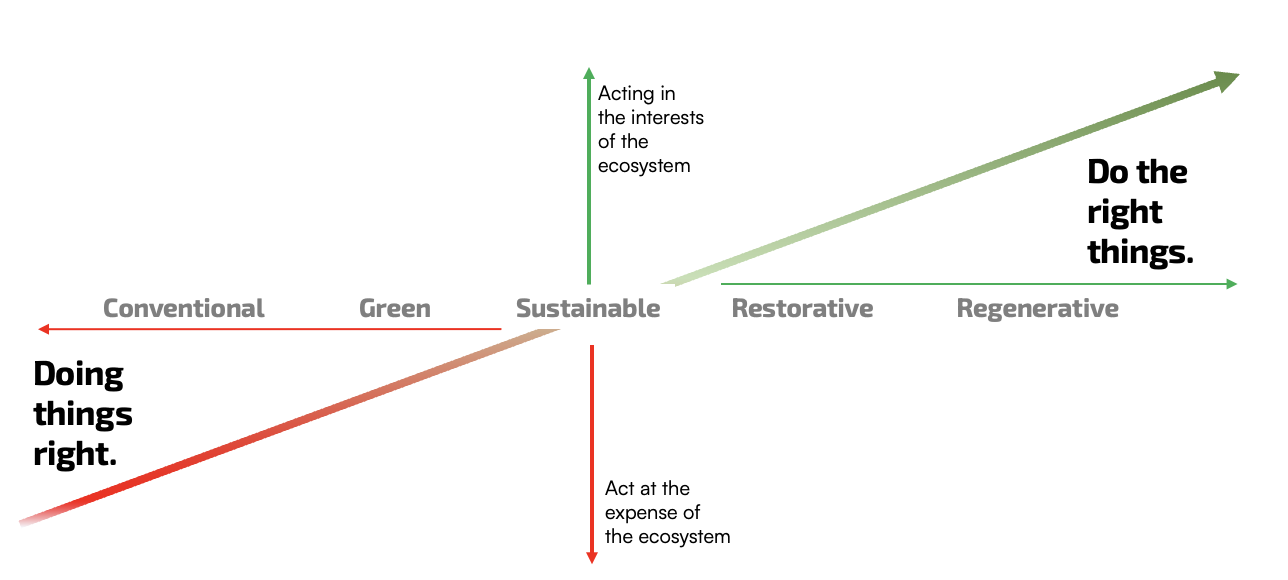What are regenerative innovations?
Innovations must not only be sustainable, but also regenerative. What is the difference between regenerative innovations and sustainable innovations?

Regenerative innovations go beyond pure sustainability, as they not only aim to minimize negative impacts, but also actively contribute to the regeneration and renewal of resources. While sustainable innovations aim to maintain the status quo and limit damage, regenerative innovations strive to actively improve and restore the environment. Through regenerative innovations, we can not only protect the environment, but also help to revitalize and strengthen it. It is important to understand this difference and move towards a regenerative mindset and practice to create a more sustainable future.

Fig. 1: Regenerative management as distinct from degenerative and sustainable management, based on Meng (2020).
The principles of regenerative innovations
Regenerative management means making a contribution to revitalization. We should strive to give back more than we take – both ecologically and socially. Companies should consider all areas of their organization and production. The aim should not only be to make things less bad, but rather to create positive value; i.e. to give more than you take. For a company, a regenerative business model means that it "[...] recognizes existing ecological and/or social problems with the help of an outside-in perspective and attempts to solve them entrepreneurially. For existing companies, this usually means a comprehensive transformation of existing logics."(Prof. Dr. Stephan Hankammer, Josa Gräber, Axel Rungweber)
The principles of regenerative innovation encompass various approaches and strategies aimed at protecting and revitalizing the environment. The circular economy promotes the use and reuse of resources in order to minimize waste and thus reduce the impact on the environment. Regenerative agriculture relies on sustainable farming methods that promote soil health and help to reduce environmental pollution. The use of renewable energies such as sun, wind, and water enables sustainable energy generation. In addition, collaborative and participatory approaches play an important role by actively involving local communities and stakeholders in the innovation process. By applying these principles, regenerative innovations can help shape a more sustainable future and have a positive impact on the environment and society as a whole.
- Circular economy: Use and reuse of resources to minimize waste.
- Regenerative agriculture: Managing land in a sustainable way that promotes soil health and reduces environmental impact.
- Renewable energies: Use of natural resources such as sun, wind, and water to generate energy.
- Community and participatory approaches: Involving local communities and stakeholders in the innovation process.
Examples of regenerative innovations
In agriculture, regenerative innovations can include the introduction of agroforestry systems, where trees are combined with agricultural crops to improve soil health, promote biodiversity, and increase carbon storage. By integrating traditional knowledge and modern technology, farmers can adopt sustainable practices that reduce environmental damage while increasing yields.
In the field of urban planning, regenerative innovations can be used to create more than just green infrastructure and sustainable cities.
Bio-composites for the construction industry may soon come from waste products from mushroom cultivation (possibly from food production). This would close a resource gap and, at the end of its life cycle, the building product could possibly even be compostable.
Advantages and challenges of regenerative innovations
The advantages of regenerative innovations lie in their holistic and long-term impact on the environment and society. Through regenerative innovations, we can minimize negative impacts and actively contribute to the regeneration and renewal of resources. This leads to sustainable development that goes beyond mere "damage limitation" and enables a positive transformation of our way of life. By focusing on regenerative innovations, we can not only protect the environment, but also improve the quality of life, increase resilience to environmental change, and achieve long-term economic benefits. Ultimately, regenerative innovations offer the opportunity to create a more sustainable and livable future for generations to come.
As important and promising as regenerative innovations are, they also face various challenges and obstacles that can make their implementation more difficult.
- Technological barriers play a decisive role, as the availability and scalability of renewable technologies are often still limited. The development and implementation of new technologies requires time, resources, and research, which can slow down the process.
- Political and regulatory hurdles also pose a challenge.
- Economic interests and resistance from established industries or interest groups that benefit from the current situation can also hinder the implementation of regenerative innovations. It requires a rethink and a reorientation of economic interests to enable the transition to a regenerative economy.
The role of companies and society
It is the responsibility of companies to drive forward regenerative innovations and develop sustainable business models. By integrating regenerative practices into their business strategies, companies can help reduce their environmental impact and make a positive contribution to society. It is important that companies recognize their social and environmental responsibility and actively take measures to create a more sustainable future.
Consumer and user awareness also plays a decisive role in promoting regenerative innovations. The demand for sustainable and regenerative products and services is growing steadily. As soon as the demand for regenerative products and services on the market is only slightly discernible for a company, it should react to it. To ensure this, it helps to keep an eye on the past, present and future with roadmapping.
Conclusion: regenerative innovations and their importance for overcoming global challenges
By developing and implementing regenerative innovations, we can protect and revitalize the environment. This approach allows us to go beyond conventional sustainable practices and bring about real change. By focusing on regenerative innovations, we can have a positive impact on the environment and society as a whole and thus make an important contribution to overcoming global challenges.
Quellen:
Pamela Mang (2020): Regenerative Development and Design.









